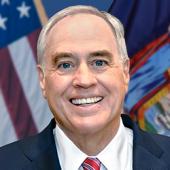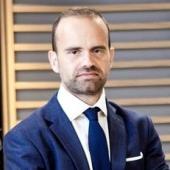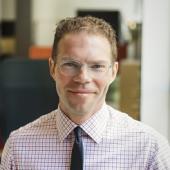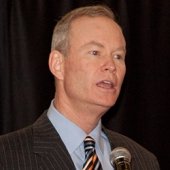CIO panel: Public-private partnerships and successful smart cities
IN BRIEF
- 3:00 – Public-private partnerships: “In this model, economic development and quality of life become a shared public-private and community concern and have the potential to increase transparency, reduce equity gaps, and meet community needs more than a one-sided development would do.”
- 9:45 – Lit up like a Christmas tree: “One of the things that we did at the city of Aurora in trying to make it more attractive for businesses, we focused on basically making the city kind of an incubation lab, but not in the traditional sense of just creating an innovation district, but we’ve made the entire city an innovation district.”
- 19:15 – Digital infrastructure: “The same way that roads, rails and ports supported the economic explosion of the Industrial Revolution, I believe that digital infrastructure will allow for the transformation to smarter cities and the community-wide connectivity that will be necessary to democratize innovation, opportunity and hope.”
Peggy James, Dean of the College of Social Sciences and Professional Studies at the University of Wisconsin-Parkside; Michael Pegues, the CIO of the City of Aurora, Illinois; and William Martin, the CIO of the city of Racine; Wisconsin join Joe Kornik, VISON by Protiviti’s Editor-in-Chief, to discuss smart city projects underway in their communities and the importance of public-private partnerships in building a sustainable, community-oriented future city.
CIO PANEL: PUBLIC-PRIVATE PARTNERSHIPS AND SUCCESSFUL SMART CITIES - Video transcript
Joe Kornik: Welcome to the VISION by Protiviti interview. I’m Joe Kornik, Director of Brand Publishing and Editor-In-Chief of VISION by Protiviti, our content initiative where we look into the future to examine the strategic implications of big topics that will impact the C-Suite and executive boardrooms worldwide. In this, our first topic, the future of cities, we’re exploring the evolution urban areas are undergoing post-COVID, and how those changes will alter cities over the next decade and beyond.
Today, we’re focusing in on successful smart cities, and specifically the role of public-private partnership in that success. We’ve got a great panel for you today. I’m joined by Peggy James, Dean College of Social Sciences and Professional Studies at the University of Wisconsin-Parkside; Michael Pegues, the CIO of the City of Aurora, Illinois; and William Martin, the CIO of the city of Racine; Wisconsin. Peggy, Michael, and William, thank you so much for being here today. You’ve all talked a lot about the significance of the public-private partnership and its role in the success of cities, both today and in the future. I know you all have perspective on that topic. So, let’s open up with a question for all of you about that public-private partnership and the role that relationship plays in the future of smart cities. Why is it so important to get that right? Why is it so important that we get that public-private partnership right for the future of cities?
Peggy James: Well, if I could start, Joe, first of all, thank you for having us. I think this is a really important discussion. I appreciate the fact that you’ve also allowed folks from outside city government to participate. I’d like to start off by at least making an observation that three-quarters of the folks living in the United States right now are living in small and mid-sized cities. In Wisconsin, the fastest growing cities that we had in 2020 with double-digit growth were all cities with less than 50,000 people. So, suffice it to say that smaller communities are revitalizing downtown areas, they’re developing commercial ventures and non-revenue producing property, they’re repairing roads, and they’re looking into using smart technology to improve transportation, improve healthcare, and actually improve utility provision across the board. Although these developments are really good for property values and increased revenues, our smaller communities simply don’t have the funds to leverage these projects at the outset. They can’t afford to make mistakes. A partnership, and I need to make sure that we understand this, is a long-term dynamic relationship rather than a simple contract for services; allows the city to actually share some risk, share some revenue, and also, from my point of view, share responsibility to the community. For us, it’s the last one that’s important. Economic development and quality of life become a shared public-private and community concern in this kind of a partnership and has the potential to increase transparency, reduce equity gaps, and meet community needs more than a one-sided development would do. The university is one of those agents that can actually help to connect the community with both the private and public sectors, to inform the partnership and to provide assessment of the value creation for the community.
Joe Kornik: Well, do you have any thoughts on that first question?
William Martin: Well, I think Peggy did a great job of really summarizing the landscape that we’re in. As someone who represents a city that is under a hundred thousand in population, and something like 98% of all American municipalities are that size or smaller, we really are not in a situation where we’re ever going to have all of the human talent, all the ability to research, and think about the forward opportunities. Financially, we just aren’t ever going to be in a position to do this all alone. So, for all those reasons, and so much more, it is not just a value added to have public-private partnerships, it’s essential that we could not possibly begin and sustain the transformation towards smarter city status without having the private sector, the higher education, and others at the table with us. That’s what really makes this an exciting opportunity and allows us to really grow in a sustainable way.
Joe Kornik: Michael?
Michael Pegues: Yes. Just a caveat on what Peggy has said, and Will, and I totally agree. I mean, just with all of the things that have happened here over the last year, and actually beyond that, I mean, municipalities themselves, we need to look at how we redefine standards, whether that’s public safety, city services, inclusive internet access, and just being innovative in economic development and attracting new businesses to the city of Aurora. It’s like, I get it, I’ve been here working for the city for about the last four years. The city’s job is to have good streets, have good sidewalks, to get the water bill paid, and things like that. Those are the services that the residents come to expect. The budgets are predefined according to those drivers. Now, as we go into this fourth industrial revolution when we start to look at cyber security, artificial intelligence, right?, infrastructure modernization, next generation technology, I mean, these are all different technologies that need to be used to advance us forward. The citizens really don’t care about that. Even more importantly, they don’t understand it, right? So, how do we make that transparent to the constituents so they see the value, they see the outcomes, they see the impact without all of the technology jargon behind it. Because those are just the underpinning foundation to help us push it forward. Looking at this is that municipalities aren’t in a position to drive innovation. That’s the bottom line. I mean, I’ve worked in the private sector. I’ve worked in Department of Defense. I work in a municipality now. We don’t do a good job at it. We do a good job at sidewalk street, cutting tree branches, and things of that nature. That’s why we have to partner with the universities, and more importantly, with the businesses that the private sector, who know how to get the best bang for their buck and get that ROI. They know how to model these services and these solutions. Going back to what Will said, actually, about — I’m going to call it the human talent or the people, the personnel — government just does not incentivize and/or attract the right talent to drive innovation. I mean, we need to come to a realization. Government means bureaucracy. Innovation is the opposite of that. The quicker we understand that, and we figure out models to basically manage that forward, the better off we’re going to be. I personally think, unequivocally, that that’s in public-private partnerships.
Joe Kornik: Right, a key part obviously of this. Will, I know Racine was awarded a North American Smart City designation and is the only city with a population under 100,000, I believe, to receive that award, which is a quite impressive feat. So, talk to me a little bit about what made that possible and what it does for the city of Racine moving forward.
William Martin: Well, no, thank you very much. We are so excited about the fact that we were able to win that designation in part working with folks like Dean James in the University of Wisconsin-Parkside. Bringing together the technical college, the four-year university private sector partners as well from the for-profit business sector, and having governments there, bringing all that together, we really were able — even though we’re the smallest ever, we brought together a coalition that was extraordinarily large. Knowing that, again, we just didn’t have the resources in the 360 to be able to think through all the implications, of policy, of the technology, of confidentiality. There’s just so many different aspects, and having such a small organization, this allowed us to force multiplier of having those public-private partnerships to get together and actually do a better job of moving forward as a group. The other piece of this, though, I would say equally importantly is our willingness to reimagine ourselves. We’re seen as a place that has long been defined by what we made here. Now, as a post-industrial city, we’re really reimagining ourselves as to how do we create through asset mapping and other thinking about what do we have to offer, what differentiates us. I think these are the processes that any city of any size really needs to think through as they’re considering their public-private partnerships and how they might achieve such designations.
Joe Kornik: Right. Michael, Aurora is a little bit bigger than Racine. I think it’s a little more than 200,000. Can you discuss the work you’ve done around attracting companies to Aurora? I know that’s been a big piece of your strategy, and how that impacts the city today and how it will continue to in the future?
Michael Pegues: Absolutely, Joe. That’s a very interesting question. I mean, one of the things that we did at the city of Aurora in trying to make it more attractive for businesses, we focused on basically making the city of Aurora kind of a test bed or an incubation lab, but not in the traditional sense of just creating an innovation district in a small area, but we’ve made the entire city an innovation district. We’ve coined it “the 605 Innovation District”; 605, why? Because it’s the first three prefixes of the zip code. We have five zip codes in the city of Aurora. The city of Aurora sits in four counties as well, which is very unique. So, we said, “Why don’t we just make the entire city the innovation district? Let’s not limit ourselves.” Because one of the main drivers was because of our fiber optic network that sits under the ground. We have a 45-mile ring that goes around the city, and about 50 miles of laterals that basically extend off of it. So, the city’s lit up like a Christmas tree. That’s pretty attractive to a lot of business, especially a lot of tech companies, and also small, medium, large, but more importantly, entrepreneurs, the small startup companies. Because they’re trying to find a place where they can go and test their products and services. That 605 Innovation District, it just creates a hub of innovation. We have the hub which sits downtown Aurora, but there’s different spokes throughout the city. We look at, basically, how we can ignite growth here in the city of Aurora by attracting those different companies. Some of the things that we’re doing is, we basically laid out what we call it The Thousand Jobs Initiative. That global startup initiative focuses on giving incentives to different businesses, whether it’s access to different new market tax credits, whether it’s giving discounts in terms of internet access with the fiber, if it has marketing, relocation imbursements, performance-based grants. So, all these different things are very attractive when you’re an entrepreneur or startup and you’re trying to grow your business, but as well — the larger companies as well. One of the larger companies that we’ve attracted out of many here is the Chicago Mercantile Exchange. Many people don’t know the Chicago Mercantile Exchange of Chicago actually sits right here in the city of Aurora. Why? Because of our assets. One, because of the location off of the I-88 corridor, which is our technology corridor hub. Two, because of the fiber optic network. We’re talking about high frequency trading. We got towers. It goes right back downtown Chicago to the Equinix Data Center, which is the telecom hub for the Midwest. Everything comes in and out of the Equinix Data Center. Also, it sits right next to ComEd power stations. You need power for data centers, right? You need fiber. We have — they have access to, I’m going to say cheap land compared to Chicago. Also, we have a mayor with a vision that is next to none. That’s how we’re attracting these businesses, right? We’re partnering with them, we said, “Here’s our infrastructure. Here’s some of our assets. How can we partner together to increase the GDP and the economic development for these different businesses?” That’s just one case study, and there’s a lot more. We just continue to grow.
Joe Kornik: Right. So, that collaboration is really interesting, I think, Michael. Peggy, I know collaboration between the university and the citizens, that idea of community readiness for smart cities is central to your mission. At least I think it is. Can you talk a little bit about that education process and where the University of Wisconsin-Parkside fits into that equation?
Peggy James: It absolutely is essential to our mission. I think it’s central to a lot of especially regional universities who have a strong tie with the community and have a commitment to increasing citizen well-being, not just for education, but economic development and just basically quality of life. I think the university actually brings a unique voice to these sorts of partnerships. I would say even though I know I’ve got two government folks here with me, I’d say that it’s not uncommon for governments to respond to community needs in ways that might favor some groups over others. That might not be intentional, but the fact is that some groups have louder voices than others. Some groups are more attuned to what’s going on. I think that the university can help transform that P3 relationship to what is a new term for this, and I say it just because I love acronyms, is a CBP3, which is a community-based public-private partnership. These partnerships, which include the community, are a much longer term than we might normally be thinking of, especially in our classic transportation P3s. They’re flexible enough to adapt to economic and community changes with community input. One of their objectives, typically, is equitable outcomes that are available for everyone. Maybe not at the same time, but over the long run. Many of these early CBP3s [Laughter] emphasize green infrastructure or environmental challenges, such as water usage and water provision. So, as I said, universities, especially our regional campuses, have the ability to connect community stakeholders to the partnerships throughout the entire process. I’ll give you an example at UW-Parkside. We’re located smack in the middle of two mid-sized communities and a number of smaller municipalities. We can serve, and we do serve as a convener, as a mediator, as a connection for all parties. The advantage to having this third agent is that we have a foot in both private and public spaces and a commitment to social equity as well as the economic development that would increase well-being. So, it’s sort of — I supposed you could call it a middleman, and many times, middleman actually do work in P3s. Often, they are regional development corporations, for instance, that have both a business and a community interest. The university can provide that function.
Joe Kornik: Thanks so much. Very, very important. I’ve got one more question. It’s may last one. If we could, let’s dream a little bit about Racine, Aurora, and smart cities everywhere in 2030 and beyond.
Peggy James: Well, I took you seriously on this. I want to warn people that by birth, I’m actually a political scientist. So, that’s naturally where my dream goes to. I decided to just mention that I think civic technology can be a game changer, especially involving the community more directly and more immediately into all decision-making processes, not just P3. With increased transparency and the ability to provide input, the community can become a creator of services and development projects rather than solely a consumer. So, we have the ability with IoT, not only to get information, but the technology to actually have people participate on a flatter platform in decision-making that circumvents the boundaries of physical town halls, and so on. They’re not only impactful in terms of efficiency. I believe that they have the ability to transform the entire political system in a way that will make participation more transparent and more equitable. An example of this is in Chicago, although it’s a large city, and I said I wasn’t going to mention large cities, there’s a group called the City Tech Collaborative, which is a non-profit organization, and it’s specifically designed to increase access and input for citizen engagement. So, this is a way in which people can have feedback, not just on the finished product, but on the creation of services, and on the input that tells them what it is that they’re going to find to be most important for them. One of the things that UW-Parkside is doing in this area is that not only do we have a certificate in smart city policies and civic partnerships, but we’re also — and Will is helping us with this — is that we’re working on a Smart City U for government officials. It will show people what sorts of platforms are most effective for engaging citizens. We also have a private sector focused on developing a smart workforce for the future. So, our center for research and innovation in smart cities has actually been designed specifically to provide that pivotal relationship that might be necessary for participation. So, that’s my dream. [Laughter]
Joe Kornik: Fascinating. It’s a great one. Will, I’m wondering if you have any thoughts around smart cities 10 years out, let’s say.
William Martin: I will say that the same way that roads, rails, and ports really supported the economic explosion of the industrial revolution, I believe that digital infrastructure will allow for the transformation to smarter cities and the community-wide connectivity that will be necessary to democratize innovation, opportunity, and hope. So, so many people have had to move to cities for opportunity. The more that we’re able to actually support people where they’re at through high-speed, low-latency connectivity is going to allow people, whether you’re on a tribal reservation, a rural town, a small city, or a metropolis, the ability to be able to connect, to collaborate and to contribute no matter where you are. I think that truly will be the democratization of innovation.
Joe Kornik: Yes, interesting. Michael, there’s still some dreams left out there. So, what do you have for us when you think about the next 10 years?
Michael Pegues: Yes, I know my mayor keeps telling me to wake up because I think I’m always dreaming, but yes, I mean, I totally agree with Peggy and Will. I think, and with this public-private partnership, the whole objective is to make it where you can develop, finance and put in place long-term sustainable solutions that focus on public infrastructure — whether mobility, energy, transformation — and social infrastructure. One of the things that we’re looking at as part of our public-private partnership with the funders and investment firms are what they’re called these independent investment benefit corporations, where while their objective is still incinerated revenue, they have a social responsibility with regards to generating that additional revenue as well. It’s not solely ROI from a monetary spectrum, but it’s the social impact. So, that’s important for us, partnering with that right investment firm, because once we have that in place, they can help us with those models to manage this infrastructure over time. Going back to another point we talked about is access. We always talk about — I believe that technology is that common denominator for local and global growth, right? The same way that cities provide water, electricity and gas, fiber optic connectivity is that fourth utility. It’s not a luxury. It’s a necessity. There’s been the cases where we have Chattanooga or Fort Collins where we need to get that access to the people that really need it. If COVID has proven one thing to us, because I believe it’s just — it was basically an experimental — it wasn’t an experimental, it was a real-life use case to say why we need fiber optic to the home for every family, for all the 64,000 residents that we have at an affordable price, so they can have access to city services, so they can have access to education. That’s when we start to close the digital divide. So, putting these models in place with the private side, with governance, and government, and being smart about our governance and putting policies in place, that basically brings all these different pieces together. That’s going to be the way of the future, because we have to make it for 30 to 40 and even 50 years to make this work. We can’t look at these projects in the time frame of one year. It just doesn’t do any good. We can’t get the return on an investment back within that amount of time. We have to stretch it out. We need to amortize it over the 30 years, where we take the burden of the budgets and the costs off our citizens, and we start to look at generating new ways to bring revenue to the city. Because if there’s one thing that government has, it’s convening power. The mayor can snap his fingers in a minute and get everybody in the room that he would possibly need to get something done. We need to be looking at leveraging that. So, that smart city of tomorrow, we need to make our plans future-proof. We need to be smart about it. We need to make them sustainable, and we need to get the right people around the table — private, public, the educations, the people, the citizens, and bring everybody into it, looking at it from an interdisciplinary perspective, and putting a plan in place. It’s not going to be perfect, but getting that plan in place and moving it forward.
Joe Kornik: Thank you so much, Michael. Thank you all. Really, really great insights from a couple of chief information officers of cities and a dean from the college of social sciences and professional studies at the University of Wisconsin-Parkside. So, thank you Peggy. Thank you, Will. Thank you, Michael for your time today.
Peggy James is the Dean of the College of Social Sciences and Professional Studies at the University of Wisconsin-Parkside.
Michael Pegues is the CIO of the City of Aurora, Illinois.
William Martin is the CIO of the city of Racine, Wisconsin.





































